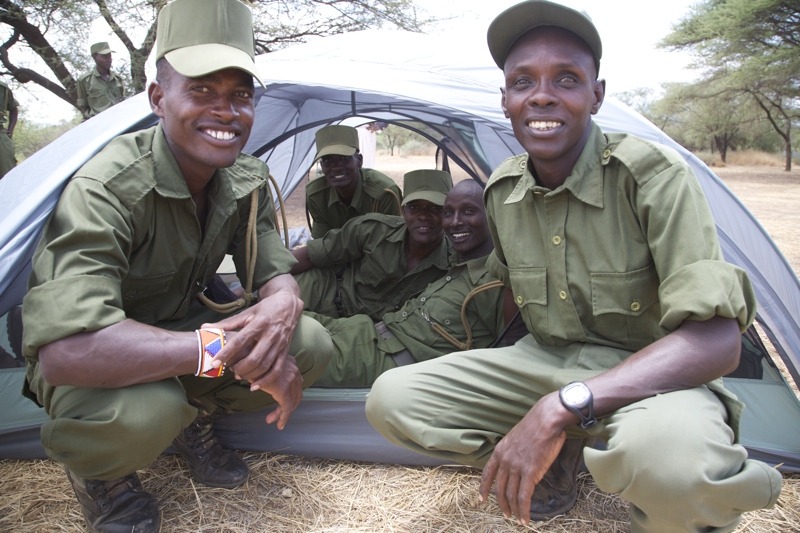
Tracking poachers through the African bush is a bit different than following a set of hoofprints in the hope of spotting a kudu for a photo safari. To start with, kudus don’t carry AK47s. Nor are they likely to double back and set up a point ambush.
Whether you’re after man or beast, tracking is an intensely focused activity. Signs are usually faint and ambiguous—a partial print here, a scuff there. It’s like trying to assemble a jigsaw puzzle with half the pieces missing. A good tracker looks ahead frequently to infer in which direction his quarry is likely to have gone, but 90% of the time his attention is directed just a few feet ahead.
And that can be hazardous if the quarry is a band of armed poachers. To improve game ranger success and personal safety, ConserVentures is working with the South Rift Game Scouts in Kenya to pay for and host a tactical tracking seminar in Kenya this October, as part of our Resources for Rangers program. Our team includes professional law enforcement officers for five days of intensive instruction.
 Demonstrating how snare wires are captured and decommissioned.The South Rift Game Scouts of the Olkirimatian and Shompole Maasai communities already know how to track—most of them have been doing it since they were crawling, and their skills were further honed by the basic training they received through the Kenya Wildlife Service (KWS). Trailing a kudu—or a leopard or dik-dik or jackal—is literally child’s play for them. But with the recent resurgence in poaching, both for ivory and rhino horn and the far larger trade in bush meat, more of their operations involve tracking people. And since even the bush meat trade has become big business, more poachers are now members of well-organized and well-funded gangs. Last year members of the South Rift Game Scouts apprehended a poacher who had murdered a game ranger. Clearly the stakes are rising.
Demonstrating how snare wires are captured and decommissioned.The South Rift Game Scouts of the Olkirimatian and Shompole Maasai communities already know how to track—most of them have been doing it since they were crawling, and their skills were further honed by the basic training they received through the Kenya Wildlife Service (KWS). Trailing a kudu—or a leopard or dik-dik or jackal—is literally child’s play for them. But with the recent resurgence in poaching, both for ivory and rhino horn and the far larger trade in bush meat, more of their operations involve tracking people. And since even the bush meat trade has become big business, more poachers are now members of well-organized and well-funded gangs. Last year members of the South Rift Game Scouts apprehended a poacher who had murdered a game ranger. Clearly the stakes are rising.
At the request of the rangers, ConserVentures has arranged and is funding a week-long seminar in tactical anti-poaching tracking to be held at the South Rift Resource Center this October. The word ‘tactical’ has been overused in the last few years, applied as a catchword to everything down to watchbands and socks—but tactical operations are exactly what the scouts will be taught. For example, in most tracking situations—game viewing or hunting—the tracker is the point man. Not in a potential ambush situation, when two or more outriders actually travel ahead of the tracker to watch for potential dangers, while attempting to avoid compromising the spoor. Obviously this takes precise coordination and effective communication, and a plan for action should hostile contact occur.
 Gary HaynesTo lead the seminar we’ve hired Gary Haynes, a retired law enforcement officer with the U.S. National Park Service, who was taught tactical man-tracking by veterans of the bush wars in southern Africa. Assisting Gary will be Michael Hardin, also a Park Service officer who has used his extensive training in man-tracking techniques to pursue and apprehend narcotics smugglers and fugitives throughout the western U.S.
Gary HaynesTo lead the seminar we’ve hired Gary Haynes, a retired law enforcement officer with the U.S. National Park Service, who was taught tactical man-tracking by veterans of the bush wars in southern Africa. Assisting Gary will be Michael Hardin, also a Park Service officer who has used his extensive training in man-tracking techniques to pursue and apprehend narcotics smugglers and fugitives throughout the western U.S.
We believe this seminar will help the South Rift Game Scouts to continue to be an effective conservation force in a large swath of some of the best wildlife habitat in Africa.
We have launched a fundraising campaign to support both the seminar and to purchase radio and field equipment for the scouts. We've raised $6,200 so far from pledges from Hydro Flask, sales of Tom Sheppard's Vehicle-Dependent Expedition Guide, and partial proceeds from the event Overland Expo. Our goal is $10,000.
Please help, every dollar counts. Donate now.
